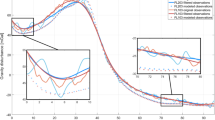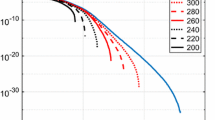Abstract.
Four integral-based methods for the inversion of gravity disturbances, derived from airborne gravity measurements, into the disturbing potential on the Bjerhammar sphere and the Earth’s surface are investigated and compared with least-squares (LS) collocation. The performance of the methods is numerically investigated using noise-free and noisy observations, which have been generated using a synthetic gravity field model. It is found that advanced interpolation of gravity disturbances at the nodes of higher-order numerical integration formulas significantly improves the performance of the integral-based methods. This is preferable to the commonly used one-point composed Newton–Cotes integration formulas, which intrinsically imply a piecewise constant interpolation over a patch centered at the observation point. It is shown that the investigated methods behave similarly for noise-free observations, but differently for noisy observations. The best results in terms of root-mean-square (RMS) height-anomaly errors are obtained when the gravity disturbances are first downward continued (inverse Poisson integral) and then transformed into potential values (Hotine integral). The latter has a strong smoothing effect, which damps high-frequency errors inherent in the downward-continued gravity disturbances. An integral method based on the single-layer representation of the disturbing potential shows a similar performance. This representation has the advantage that it can be used directly on surfaces with non-spherical geometry, whereas classical integral-based methods require an additional step if gravity field functionals have to be computed on non-spherical geometries. It is shown that defining the single-layer density on the Bjerhammar sphere gives results with the same quality as obtained when using the Earth’s topography as support for the single-layer density. A comparison of the four integral-based methods with LS collocation shows that the latter method performs slightly better in terms of RMS height-anomaly errors.
Similar content being viewed by others
Author information
Authors and Affiliations
Corresponding author
Rights and permissions
About this article
Cite this article
Alberts, B., Klees, R. A comparison of methods for the inversion of airborne gravity data. Journal of Geodesy 78, 55–65 (2004). https://doi.org/10.1007/s00190-003-0366-x
Received:
Accepted:
Published:
Issue Date:
DOI: https://doi.org/10.1007/s00190-003-0366-x




